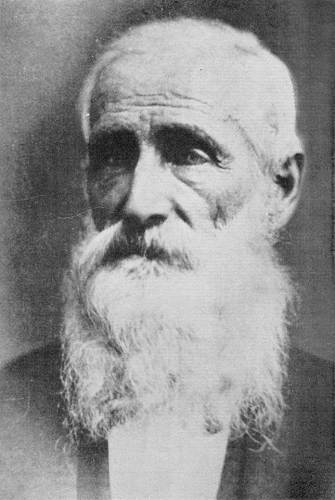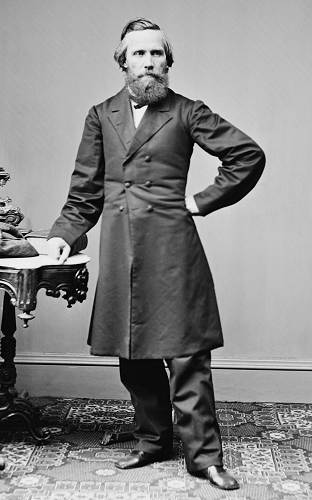|
Monday, April 29, 2013
MANY MILLER COUNTAINS HAVE DUTCH HERITAGE
by Peggy Smith Hake (published in January 1988)
There are many families living in Miller County today (primarily in the Big Richwoods area) who are descended from remarkable pioneer folks. These were the Pennsylvania Dutch ancestors who left their eastern homes to travel westward in search of a new land to homestead and settle.
In the era of 1858-59, prior to the outbreak of the Civil War, Colonel James Moore and Matthew Brown joined forces and brought their families to Missouri. Both families traveled by train from Pittsburg, PA to St. Louis; crossed the mighty Mississippi on a ferry boat; and traveled the remainder of the way by wagon. They brought a great deal of furniture and other items with them on this long trip including a Lincoln bedstead, bureau, flax spinning wheel, a stove with an oven on top, an old-fashioned child’s cradle, silverware, chinaware, and several old books which today would be classic, rare books. These books, printed on homemade paper and bound in leather, pertained to history, philosophy, religion, and classics of Greek and Latin. The publication dates ranged from 1813 to 1856; the oldest was the "Book of Martyrs" by John Malkam (1813).
I understand that Mrs. Charles Newhart, granddaughter of Col. James Moore, had possession of all these old books in the 1930s. Col. James Moore had been a Curator of the Lewisburg, PA University (now Bucknell) (photo 01).

01 James Moore, III - Father of Bucknell University His son, Edward, graduated from this fine old school in 1852.
Matthew Brown was born in Lycoming County, PA near Williamsport in 1795. When he attained manhood, he moved to Clearfield, PA and purchased a newspaper called "The Clearfield Banner" which he continued to publish until 1837. That year he went back to his home county and settled near Uniontown (now Allenwood) and engaged in general merchandising and conducted a profitable business until his decision to move west. While at Uniontown, he owned the farm where he was born which was two miles west of the small village. There he built the largest barn in White Deer Valley in east central Pennsylvania. In the spring of 1859, the Browns and Moores’ left White Deer Valley and headed toward Missouri.
I am in awe of these pioneers when I realize they were prosperous businessmen and land owners in their eastern homeland, but decided to start out on a new adventure in a strange land. It was told by the old-timers that they hoped to find a good country to raise cattle and also provide work for their boys who may otherwise have grown up in idleness.
When the Pennsylvanians arrived in Miller County, they found the country wild and sparsely populated. Grass, higher than one’s head, covered much of the fields and hills. Wild animals and game were plentiful, such as the deer, wolf, quail, turkey, fox, rabbit, and squirrel. The hills were covered with dense woods in the Big Richwoods with the oak and walnut most plentiful.
The Brown family purchased a tract of land containing 415 acres near the Tavern Creek, south of Iberia. Matthew called his new farm “Brownsylvania.” In later years, the farm was owned by David Petrikin, a grandson of Matthew Brown. Colonel Moore bought a place adjoining the Brown property toward the west containing 400 acres. Both families built log homes on their land. These homes were a new breed of architecture introduced to our part of the country… the log house was first built as two separate one-room units but connected with a common roof. They were known as "dog trot" houses. Inside the covered space, between the two log cabins, hung the winter’s supply of dried vegetables, wild animal skins, sides of bacon, and seed corn for next year’s planting. Each unit had it’s own fireplace and as their family increased, rooms were added to the top of each cabin with an outside stairway for access. The only heat these rooms had was what drifted up from the room below.
Colonel Moore put up a building and opened a general store in the area south of Iberia. He had forwarded a stock of goods from Pennsylvania so he could establish is mercantile trade in southern Miller County. His store was short-lived because, after only a few months, he died and his family had to close their new business.
A short time after their arrival to Miller County, the Civil War broke out. The Pennsylvanians were northern sympathizers. They entered this war, serving the Union forces. John D. Brown, son of Matthew, was wounded at the famous Battle of Wilson’s Creek near Springfield. He also participated in battles at Prairie Grove, Arkansas and Vicksburg, Mississippi.
The Pennsylvanians had rough times during those dark years of the Civil War. They were northerners and had supported Abraham Lincoln in the election of 1860. Many men of the county were Confederate sympathizers and they formed a military company in the early spring of 1861, pledging allegiance to the southern cause and favored secession.
In May 1861, Articles of the Confederation were drawn up by officers and riders of this newly-formed company and they issued messages to all the Dutchmen in Richwoods Township, including the Pennsylvania folk and the German immigrants, that they must sign this Oath of Allegiance --- but nobody responded… Talk about grit! There followed in the ensuing months --- some attempted lynchings, beatings, destruction of homes, livestock and harvested crops and abandonment of farms for long periods of time. This harassment continued for many months.
When military groups were formed in the Union army, the young Pennsylvanians enlisted and fought in many battles. Some of the soldiers were John Brown Tallman, Jeremiah W. Tallman (son of William), Jeremiah Tallman (son of Charles), William Brown Tallman, and John D. Brown. After the war, Jeremiah Tallman became active in Miller County politics serving as sheriff, Judge of the Probate Court, and three times was elected county treasurer. Charles Tallman served as a Justice of the Peace for a number of years; and also served a term as Associate Judge of the County Court and was appointed by the governor to an important office in January 1869, but died one month later from lung congestion.
The families of Charles and William Tallman, John Bennage, Benjamin Groff all of Lycoming County, PA and William Irwin of Mifflinburg, Union Co., PA, came to Miller County just shortly before the Civil War. Colonel Moore had written these folks telling them the land was cheap; the countryside desirable; and a man’s living was easy in Missouri. Due to his urging, they all moved here about the same time in the mid 19th century.
William Tallman was educated in the public schools at Williamsport and his first job was working for his father in the boat and shoe business. He later worked in Philadelphia at the same trade. He learned surveying and assisted in laying out the new town of Lock Haven, PA before finally getting the westward fever.
Charles Tallman spent most of his life on his father’s farm across the west branch of the Susquehanna River near Williamsport… this is gorgeous country! I took a trip through our eastern seaboard states in 1976 and I followed the Susquehanna River across Pennsylvania through Williamsport and Harrisburg, and southward into Maryland.
Charles Tallman married Isabelle Brown and they settled in White Deer Valley near the old Brown homestead. He and Isabelle reared their children on this farm. In their later years, they sold out and came to Miller County arriving in April 1860. Charles died in 1869, only one month after being appointed to an important state job by his friend, Joseph Washington McClurg, Missouri’s governor from Camden County (photo 02).

02 Joseph W. McClurg After the war, the families of David Farnham, John Hedges, William Newhardt/Newhart, John Clark, John Hess, George Johnston, and George Heltzell came to Miller County from Lycoming Co., PA. Descendants of these families are numerous today.
Most attended the only church in the area, the Big Richwoods United Baptist Church, known for a long time as "Sulky Church" (as you might suspect, there is a story behind that strange name!). The church was a log structure, built on the site of Iberia City Cemetery. Some old graves can still be found surrounding the old church, but I am sure there are more pioneers lying in the same area in unmarked graves.
The Pennsylvania families homesteaded chiefly in the Iberia vicinity. They began planting fields of corn, wheat, and alfalfa. They also raised vegetables and planted a great deal of tobacco on their new land.
The children attended a one-room school (Allen School) located about a mile east of Iberia. The land for the school was donated by Elias Allen, a native of Barren County, Kentucky who lived nearby.
Through the years these Pennsylvania pioneers continued to be important assets to the community. In 1890, when Iberia Academy was begun, the children of these settlers were among the school’s first students. By 1930, the Academy had graduated 299 students and 40 of that number were descendants of the Pennsylvania Dutch settlers. The following sent their children and grandchildren through Iberia Academy: John Bennage (5), John D. Brown (3), Matthew Brown (several grandchildren), David Farnham (8) Benjamin Groff (2), John Hedges (several), Col. Moore (3), George Johnston (2), William Irwin (4), George Heltzell (3), Charles Tallman (2). After 1930, the newer generation of these settlers continued on until the school’s closing in 1951.
The Pennsylvanians left their eastern homes many years ago, settling in Mid-Missouri, searching for their promised land. Here they found bounty in the fields as they tilled the rich earth of the Big Richwoods. It was said they were in a “promised land where you have no need to work because the land is so rich you may plant a crowbar at night and it will sprout ten-penny nails by morning.” This was a far-fetched, enthusiastic report of our Missouri country, but it brought settlers to our territory and they left us a wonderful heritage…
Until next week!
 Peggy Hake
Previous article links are in a dropdown menu at the top of all of the pages.
|

